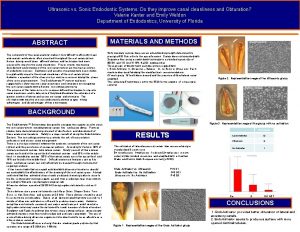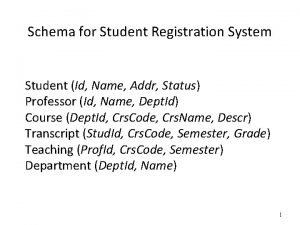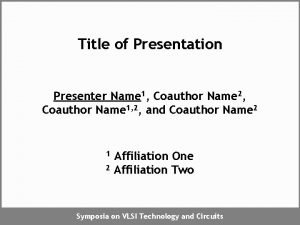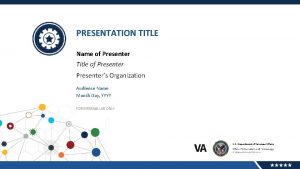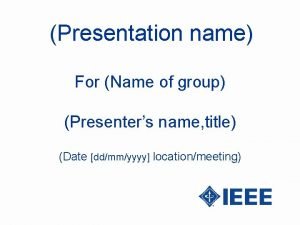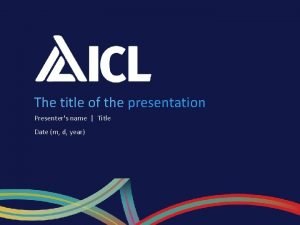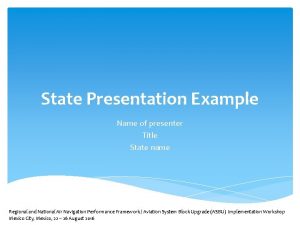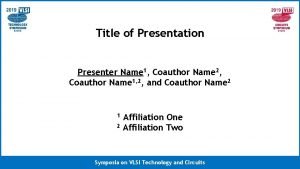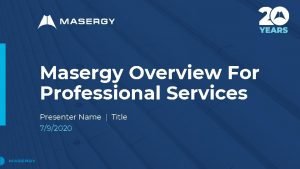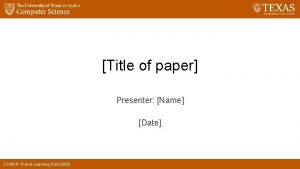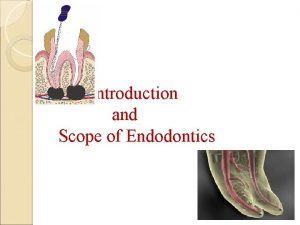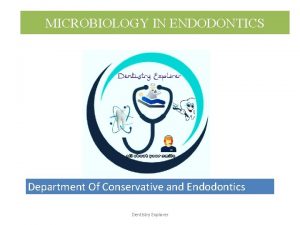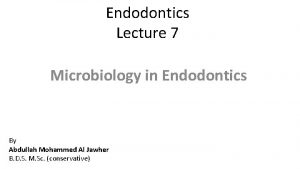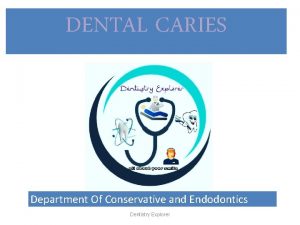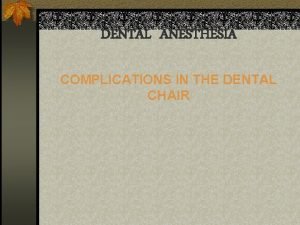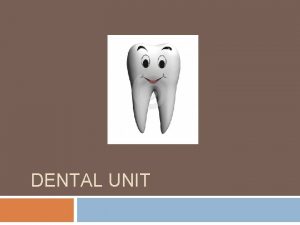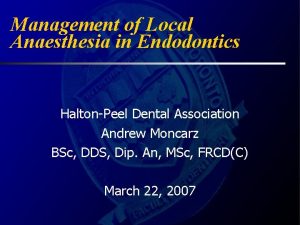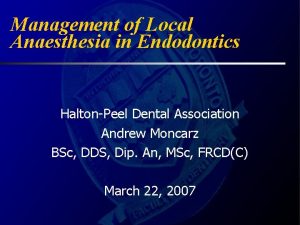Endodontics and the Dental Student Insert presenter name
![Endodontics and the Dental Student [Insert presenter name, degree] [Insert practice name] [Insert date] Endodontics and the Dental Student [Insert presenter name, degree] [Insert practice name] [Insert date]](https://slidetodoc.com/presentation_image/4bfe186713c9f579c54bf9a04e5453e1/image-1.jpg)






















![Q&A [Insert presenter name, degree, address, Web site and phone number. ] 24 Q&A [Insert presenter name, degree, address, Web site and phone number. ] 24](https://slidetodoc.com/presentation_image/4bfe186713c9f579c54bf9a04e5453e1/image-24.jpg)
- Slides: 24
![Endodontics and the Dental Student Insert presenter name degree Insert practice name Insert date Endodontics and the Dental Student [Insert presenter name, degree] [Insert practice name] [Insert date]](https://slidetodoc.com/presentation_image/4bfe186713c9f579c54bf9a04e5453e1/image-1.jpg)
Endodontics and the Dental Student [Insert presenter name, degree] [Insert practice name] [Insert date]

What We’ll Cover Today Endodontic facts Endodontists and general practitioners Using the Case Difficulty Assessment Form Careers in academia 2

Endodontic Facts Endodontics is the science of treating problems associated with the pulp tissue inside the tooth. There approximately 4, 000 active endodontists in the United States. In the past 20 years, the number of endodontists has grown by 84 percent. 3

Endodontic Facts There are 50 postdoctoral endodontic training programs nationwide. Nearly 400 postdoctoral dental students are enrolled in these programs. The number of root canals performed in the United States is growing (root canals increased by 13 percent between 1990 and 1999). Root canals account for 95 percent of procedures performed by endodontists. 4

Endodontists and General Practitioners Endodontists and general practitioners enjoy a strong reciprocal relationship. More than 95 percent of general practitioners refer patients to endodontists each year. While younger general practitioners may wish to perform their own endodontics, the quality of treatment is held to the standard of care of the specialist. 5

Endodontists and General Practitioners Endodontists have up to three additional years of specialized training in performing root canals and complex endodontic procedures. Endodontists are technical leaders in the profession and are knowledgeable about the latest treatment techniques and instruments. Once in practice, endodontists perform an average of 25 root canals per week. General practitioners perform two. 6

Endodontists and General Practitioners Endodontists treat more complex endodontic cases, while general practitioners treat basic cases. The Case Difficulty Assessment Form is designed to help general practitioners determine when to refer root canals to endodontists. 7

Benefits Of Referring To An Endodontist Most endodontists: accept emergency referrals; provide immediate relief to patients in pain; utilize advanced endodontic technologies; share in the responsibility of treating complex cases; and help keep general dentists’ practices on schedule. 8

Good Referring Dentists Good referring dentists: are educated to recognize the complexity of a case; have enough experience to understand their own abilities and limitations; and are aware of advanced equipment available to complete treatment effectively. 9

The Case Difficulty Assessment Form The Assessment Form helps practitioners assign a level of difficulty to an individual case. Minimal difficulty: routine complexity with predictable outcome Moderate difficulty: preoperative condition is complicated; predictable outcome is challenging High difficulty: preoperative condition is exceptionally complicated; predictable outcome is challenging for even the most experienced practitioner 10

The Case Difficulty Assessment Form Assess each case to determine its level of difficulty. If the level of difficulty exceeds your experience, education level and comfort, refer the patient to an endodontist. 11

The Case Difficulty Assessment Form Patient considerations Medical history (using ASA Classification System) Anesthesia Patient disposition Ability to open mouth Gag reflex Emergency condition 12

The Case Difficulty Assessment Form Diagnostic and treatment considerations Diagnosis Radiographic difficulties Position in the arch Tooth isolation Morphologic aberrations of crown Canal and root morphology Radiographic appearance of canal(s) Resorption 13

The Case Difficulty Assessment Form Additional considerations Trauma history Endodontic treatment history Periodontal-endodontic condition 14

The Case Difficulty Assessment Form Case study: abnormal anatomy Patient presents for root canal treatments in lower first and second bicuspids. It is expected that there would be two canals in the first bicuspid, one canal in the second. Photo courtesy of Dr. Sashi Nallapati 15

The Case Difficulty Assessment Form Case study: abnormal anatomy Upon treatment, it is discovered that each bicuspid has three canals. Photo courtesy of Dr. Sashi Nallapati 16

The Case Difficulty Assessment Form Case study: abnormal anatomy Photo courtesy of Dr. Sashi Nallapati Why should you refer this case? Endodontists are exposed to the most leading-edge studies on internal anatomy and have the expertise to handle such cases. Endodontists have enhanced surgical equipment, such as microscopes, for use in treatment to meet patients’ specialized needs. 17

The Case Difficulty Assessment Form Case study: medically compromised patient A female diabetic patient presents with intra-oral swelling and is in pain. She also is very anxious about dental treatment. She has a limited range of opening due to TMJ. 18

The Case Difficulty Assessment Form Case study: medically compromised patient Why should you refer this case? Because of her acute pain, anxiety and swelling, the patient is difficult to anesthetize. Endodontists have specialized training in administering anesthesia and have the necessary experience to properly manage the risks involved with this case. 19

The Case Difficulty Assessment Form Case study: medically compromised patient Why should you refer this case? The patient has limited range of opening secondary to mylo-facial pain dysfunction. Endodontists frequently work with cases of similar difficulty and can creatively address each situation more efficiently. 20

Careers in Academia Become a full- or part-time endodontic educator. Part-time positions allow you to teach while maintaining a private practice. Most universities offer flexible schedules for parttime and adjunct faculty. Part-time teaching positions complement private practice by exposing endodontists to a wide variety of complex cases and conditions. 21

Careers in Academia By pursuing an academic career in endodontics you will: shape the minds of tomorrow’s professionals; influence dental education policies; develop advances in oral health through research; benefit from life-long learning; help alleviate the crisis in dental education; and give back to your community, profession and specialty. 22

Careers in Academia For more information, visit www. rootcanalspecialists. org or the American Dental Education Association at www. adea. org. 23
![QA Insert presenter name degree address Web site and phone number 24 Q&A [Insert presenter name, degree, address, Web site and phone number. ] 24](https://slidetodoc.com/presentation_image/4bfe186713c9f579c54bf9a04e5453e1/image-24.jpg)
Q&A [Insert presenter name, degree, address, Web site and phone number. ] 24
 Insert presenter
Insert presenter Class maths student student1 class student string name
Class maths student student1 class student string name Difference between sonic and ultrasonic in endodontics
Difference between sonic and ultrasonic in endodontics Student id name department name
Student id name department name Presentation by name
Presentation by name Rgb presenters
Rgb presenters Presenter name
Presenter name Annoying create and craft presenters
Annoying create and craft presenters Presenters name
Presenters name Name presentation
Name presentation Name/title of presenter
Name/title of presenter What is the name of the presenter
What is the name of the presenter Presenter name
Presenter name Presenter company
Presenter company Younique presenter ms name
Younique presenter ms name Name of presentation
Name of presentation Presenter's name
Presenter's name Title of presenter
Title of presenter Presenter's name
Presenter's name Presenter's name
Presenter's name Name/title of presenter
Name/title of presenter Paper presenter
Paper presenter Company presenter
Company presenter Slidetodoc.com
Slidetodoc.com Presenter's name
Presenter's name


